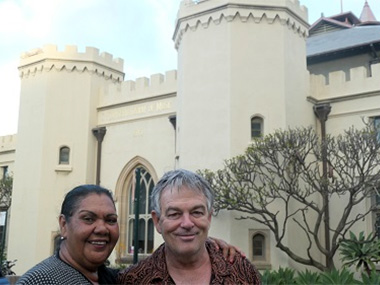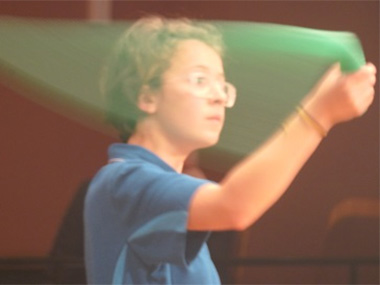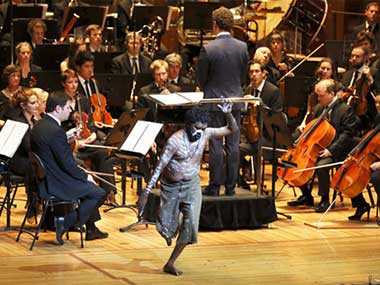Jandamarra: Sing for the Country : Ngalanyabarra Muwayi.u

June Oscar and Steve Hawke - co-creators of 'Jandamarra' - outside the Sydney Conservatorium during rehearsals
Posted by Jeremy Eccles | 16.10.19
Dates:
18.10.19
: 20.10.19
Location: Sydney Town Hall
If you are in Sydney on Friday, it would be a mistake to miss out on the single performance of 'Jandamarra', the dramatic cantata telling the story of Aboriginal Australia's Ned Kelly – the Geronimo of the Kimberley. Killed by the cops at the age of 23 in 1879, he'd lead a 3-year insurrection against the white invasion of the Kimberley on behalf of his resident Bunuba people. And this classical music version is very much their telling of the story, handed down orally through six generations of Bunuba.
This presentation is a saga in itself. Steve Hawke – son of Bob and Hazel – first went to the Kimberley 40 years ago to fight for land rights at Noonkanbah Station. The story of Jandamarra entered his life soon after, and, with June Oscar – now the Aboriginal and Torres Strait Islander Social Justice Commissioner, but then a Bunuba linguist, song woman and alcohol campaigner – they dreamed of a film that would turn their man into a nationally, even internationally known, freedom fighter.
That film is still in their dreams. But a junba song cycle, an epic play by Hawke performed a couple of times in the West, and in 2014 this composition by Paul Stanhope commissioned by the Sydney Symphony have all happened. And that 2014 performance was hailed as "fucking fantastic" by Hawke! Stanhope's position as a composition teacher at the Sydney Conservatorium has allowed the mighty forces involved to be pulled together again this week.
For, as the SSO explained in 2014, "In order to tell the story of Jandamarra through song, a vast array of soundscapes have been brought together. Two boy soloists, a children’s choir, larger and smaller four-part choirs, a solo baritone, a large orchestral palette and the earthy sounds of traditional music from the Kimberley all combine in this epic tale".
The composer Stanhope added: "'Jandamarra' is unified by a number of devices: the re-appearance of verses of the Yilimbirri Junba is one unique aspect of the piece, but they're complemented by other musical themes, such as the Jandamarra’s Spirit motif, first heard in the Prelude. This theme also returns in Sing to the Land and is woven into the polyphonic texture of Dirrari Lament. The mysterious Yilimbirri Unggud – the snake spirit from the Yilimbirri spring – is also given special musical treatment with a curling motif found in the bass clarinet, low reeds and an air of percussion mysticism, evoked by gongs, cymbals and tam tam. Incorporating this wonderful Kimberley music into the cantata has been an immense privilege, involving four research trips to work with the musicians and to gain an understanding of their beautiful country".
June Oscar justifies: ‘A major theme of the play is the power of song: its central role in the life of the community; its role in celebrating and remembering country; Jandamarra’s quest to “sing home” the rainbow snake Yilimbirri Unggud in order to heal the land. This made the notion of a choral work drawing from the story and the play seem especially appropriate and exciting to the Bunuba Community".
And that community has a brave history of freedom fighting against the white pastoral incursion. Even before Jandamarra came along, according to Hawke's poetic libretto, "we were burning their stinking sheep and the grass they fed on".
Jandamarra himself was a young man torn between these two worlds. His mother took him on to Lennard River Station with her at the age of 11. He learnt English and befriended the owner's son, and when Bill Richardson was employed by the family, got to know him well enough to become his tracker when he became a police constable. Jandamarra's tracking involved the arrest of many fellow Bunuba for killing sheep and their exile to Rotnest or Roebourne. It didn't help that Jandamarra (or Pigeon as he was known by Richardson) had been cut off from his people for 'wrong-skin' womanising.
However, the Bunuba found a way to win him back. Elders got themselves arrested en masse forcing Jandamarra to realise the threat to his people's survival. At which, he shot Richardson and freed the elders. A frontal attack on a police camp saw many Bunuba wounded – including Jandamarra. He developed guerrilla tactics instead – hitting the increasing numbers of police sent to kill him, then disappearing into the caves of Windjana Gorge and the Oscar Ranges. His fellows called him Jalgangurru – invulnerable to the police bullets.
But an attack on a police camp at 6 Mile saw him badly wounded and a fellow tracker lead his killers to a hideout in Tunnel Creek, where Jandamarra met his death.
Singers – including June Oscar – and dancers have come from the Kimberley to join the Conservatorium Orchestra, angelic girls from the Sydney Children's Choir plus the ranks of four other choirs, a baritone for Jandamarra, two narrators (black and white, and surtitles), all under dynamic conductor Elizabeth Scott.
Don't miss it!
And why not make a weekend of it, heading for the Australian Poetry Slam finals at the Sydney Opera House on Sunday evening at 7.30?? Performing will be the 2018 APS National Champion, Melanie Mununggurr-Williams. And Mununggurr is also a doughty Yolngu name in the art world. Last year's winning poem by her, 'I Run', might have had Jandamarra instinctively in mind:
"I call myself a runner – away from my problems.
But, like a black-tracker, my problems find me
Caught between a white man's world and the ancient Aboriginal one.
Salty sweat will one day bathe me clean".
URL: https://boxoffice-music.sydney.edu.au/WebPages/Show/ShowDatesCombo
Share this:
»  del.icio.us
»
del.icio.us
»  Digg it
»
Digg it
»  reddit
»
reddit
»  Google
»
Google
»  StumbleUpon
»
StumbleUpon
»  Technorati
»
Technorati
»  Facebook
Facebook
Contact Details

One of the Sydney Children's Choir members operating a whirly during rehearsals

At the 2014 performance by the Sydney Symphony, Bunuba man Emmanuel Brown dances the Lirrga Wangga as Jandamarra
Further Research
News Tags: Australian Poetry Slam | Bunuba people | Jandamarra | Jeremy Eccles | June Oscar | Melanie Mununggurr-Williams | Paul Stanhope | Steve Hawke | Sydney Conservatorium
News Categories: Blog | Event | News | Other Event
Exhibition Archive
- 11.05.20 | BIDYADANGA CLOSE-UP
- 07.05.20 | Boomerang Back to the Start
- 29.04.20 | Cooked???
- 24.04.20 | Mrs Ngallametta
- 23.04.20 | NATSIAA Pre-Selections Revealed
- 20.04.20 | CIAF 2020
- 10.04.20 | Marginally Good News
- 06.04.20 | ON & OFF IN ABORIGINAL ART
- 26.03.20 | Out on Country!
- 19.03.20 | BIENNALE OF SYDNEY 2020
- 13.03.20 | LAURIE NILSEN
- 03.03.20 | EMILY v CLIFFORD
- 02.03.20 | The Ephemeral and the Ineradicable
- 25.02.20 | WADJUK IN THE BLACK
- 17.12.19 | Sotheby's NY Inaugural Aboriginal Art Auction
Advertising

